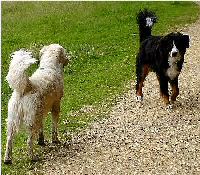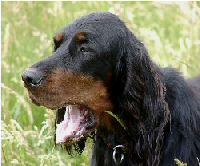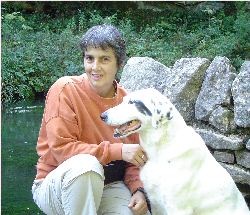Learning the language...
 The first step towards
gaining good handling skills is through awareness, and where better to start than with
understanding your dogs' body language?
Behaviour counsellor and dog trainer Sheila Harper has give us permission to post this article
from her newsletter. The first step towards
gaining good handling skills is through awareness, and where better to start than with
understanding your dogs' body language?
Behaviour counsellor and dog trainer Sheila Harper has give us permission to post this article
from her newsletter.
Understanding your dog is a vital part of your relationship. It can help you recognise the
difference between what he needs and what he wants. It can help you anticipate how he is
likely to respond in a situation, and he can let you know what he can and can't deal with.
This also means that in understanding what he is trying to say, you and those around you are
likely to be much safer, as you can read and respond to his frame of mind, and also to that of
other dogs.
Although many people recognise when their dogs are upset or fearful, the tendency is to only
listen when they begin to bark, whine or growl. By the time a dog has reached the stage where
he needs to vocalise, he is often quite high in emotion. A dog will often only resort to being
vocal or to lunging or biting if his earlier language has been overlooked or ignored.
In
fact, a dog's first choice of communication is body language. Because it is so visual the
message is usually immediate, although to a human it can seem to be very subtle, As humans, we
also use body language all the time, but because we rely so heavily on the spoken language we
have lost much of our awareness of others' body language.
Our
dogs use their body language in almost every interaction with us, but unfortunately a lot of
this information becomes lost in translation and is frequently misinterpreted. This means that
the communication we use with our dogs tends to be one way. We may talk to them, but we are
rarely aware of the range of things they are trying to tell us.
Through evolution, dogs have developed their own sophisticated language and skills which enable
them to be very effective in diffusing situations, avoiding conflicts and supporting others or
seeking support according to their own skill levels. A dog may choose to remove himself from a
difficult situation as long as he is able to do so. Whatever the case, he will do his best to
communicate with the other species involved, whether that be dog, human or another animal, in
order to manage the situation in the best way possible.
Improving our skills
In order
to develop a better understanding of our dog's language, it's important to first learn some
basics. It is important to remain open-minded, to notice how and when a dog uses his body, and
to try not to make interpretations too early. With this knowledge in mind, we are ready to
start observing our dogs.
Being
aware at the number and variety of signs shown, along with the context in which the language is
shown will give valuable information about how the dog is experiencing the situation and
whether he needs support. Once we can recognise a variety of signs, it will become clear that
the dog will show how he feels.
Large
body movements or postures are visible from a distance and they are often used early in the
communication process. More subtle language includes facial signals, such as licking the nose
or narrowing the eyes.
Body movements
First of
all, we should make a note of things that we might see. What they mean can be considered
later.
Raised
hackles, stiff movements, turning the head, body tension, curving when approaching another dog,
and even sitting down, are some of the ways dogs may use to communicate. However, if we only
look at each movement or posture in isolation, we may misunderstand the reason behind the
action. Of course, dogs don't always sit because they are trying to communicate. Sometimes,
it's just that it's more comfortable. This means that considering the context of the action is
extremely important.
 Curving Curving
A mature dog with good social skills will rarely approach another dog straight on as
it's simply not polite to do so. If dogs have had little guidance or support in their scialisation with other dogs or people, as is often seen in adolescents, for example, they may
tend to approach very directly. This can be quite uncomfortable or even provocative for the
other individual, and can even cause a reaction. As with most inappropriate behaviour, it is
not the amount of socialisation that a dog has had, it's actually the quality of
socialisation that is important, and whether they have been able to learn appropriate skills.
Being
in a position where making a curve is possible or sensible, some dogs will take themselves well
out of the way, even going out of sight. A dog with good skills will curve, but the extent
depends upon the body language shown by the approaching individual.
<image> Head
turning. This is used in a variety of contexts, but often where another dog or person
approaches, or a situation where another individual is too close. Head turning helps to
diffuse situations. If he finds himself in a tight situation where he is uncomfortable he may
turn his head slowly and remain very still: a clear warning to back off.
When
dogs are meeting for the first time, head turning in quick succession is often seen. In many
instances both dogs can be seen using these movements along with other signals, communicating
to each other to show they are not a threat as they move closer to each other.
<image> Sitting — a diffusing behaviour. Sitting could simply mean that a dog is unsure and as
it is a non-threatening action this may be the best option to prevent escalation. If a dog
turns his back when sitting, it usually means that he doesn't want anything to do with the
situation, and is making it clear.
The tail
The tail can
indicate a range of emotions, and of course a wagging tail doesn't necessarily mean a happy
dog. It is important to look at the tail in combination with other signs the dog is giving.
-
A fast wag may mean that the dog is excited.
-
A low slow wag shows that the dog is unsure of the situation and in combination with a
slightly lowered head or a direct look is likely to be a warning.
-
A high tail usually indicates a dog that is insecure and doesn't know what to expect.
It is most commonly seen when unfamiliar dogs first meet, where one or both dogs show the other
that they feel uncomfortable.
Facial communication
Facial
communication gives a clear opportunity to see that unless the context is taken into account
misinterpretation can arise:
Licking the nose. A quick, subtle tongue flick, often missed by the inexperienced observer.
If food is present this action is often interpreted as the dog anticipating receiving a treat.
However, accompanied with averting the eyes, it is more likely to be the acknowledgment of a
situation. A more obvious lick can occur if no notice has been taken of any previous subtle
signs, for example if a young or pushy dog is present.
 Yawning
Yawning
Of course dogs yawn when they are tired, but more commonly yawning is seen as a
diffusing behaviour. A really obvious yawn often indicates a dog who feels uncomfortable.
Narrowing the eyes
Dogs often narrow their eyes in acknowledgement to a situation, and may
be accompanied by sniffing the ground or head-dipping.
Body
movements alone or in combination with other signs are still only a part of the picture. Other
significant factors to take into consideration are the intensity, frequency, and duration of
any communication, as these are a good indication of how strongly the dog feels about a
situation.
Dogs
tend to use the environment to diffuse situations, seemingly “pretending” to become involved in
a natural behaviour. This has parallels in human behaviour where someone might fiddle with a
mobile phone in order to give himself a few extra moments to deal with challenging
circumstances.
An
example of this is sniffing the ground which a dog may use to acknowledge the presence of
another dog. However, in a similar situation but where the dog is sniffing intensely or
frequently, he may be indicating that he is uncomfortable. Of course, it could mean that he
has found an interesting scent, and this again is why it is important to look at the context in
which the behaviour is shown.
Dog
to dog communication
By nature
dogs are peace keepers. Their language is designed to diffuse situations, and when they have
the opportunity to learn good communication in their early lives few problems arise. However,
if young dogs have little guidance or are allowed to behave impolitely with other dogs,
tensions may escalate. Puppies and adolescent dogs often break the rules of polite
communication especially if they have had negative or frightening experiences themselves.
Dogs
with little life experience such as young dogs, or who have had no guidance in their contact
with other dogs are more likely to ignore the subtle signals that another dog is giving them.
Inappropriate behaviours such as dashing over to other dogs, jumping at them, and behaving in a
pushy manner are unfortunately commonplace in some of these dogs and can be the cause of
conflict. The dog affected will often try to diffuse the situation with his body language,
knowing that the other dog should have the skills to pick up on it. If not they may well bark
or growl, and as a last resort, snap or nip. Unfortunately, being forced into this kind of
response can lead to lasting communication issues for both parties.
In
order to avoid such behaviour it is much better if owners can find opportunities for their
puppy to mix individually with older, well-balanced dogs so that they can learn the
communication skills and etiquette that they need to make them a good canine citizen. However,
the owner still needs to intervene if the puppy pesters the adult dog by moving between them
and splitting up just as dogs do when mediating between members of their own species.
Dog
to human communication
Our
dogs are always using body language to communicate with us. The only thing that stops us from
listening to them is our lack of awareness and understanding. This means that it is vital for
us to learn what they are saying and to respond appropriately.
Understanding basic communication is essential for a positive relationship between dog and
owner, but this is just the beginning: it's what we do with that information that is really
important. Understanding the way a dog communicates should be a way of life. If we understand
what our dogs are saying to us, and listen to them, we could support them better and diffuse
many difficult or potentially dangerous situations. By not responding to our dogs attempts to
communicate with us, we make life much more difficult for all concerned. If we constantly
overlook his subtle signs, he will eventually skip these all together and will jump straight to
barking, or worse, biting — his last resort. We are constantly, unwittingly, putting our dogs
into difficult, potentially dangerous situations, expecting them to cope. We effectively ignore
much of their communication, leaving them little option but to “shout louder” which results in
unwanted behaviour such as lunging, barking and biting. If we could just listen and understand
the signals our dogs are giving off, we could avoid these situations, and through this
understanding enhance the human/dog relationship.
Instead we tend to issue commands, raise our voices or even punish dogs for using behaviour
that within their own society is perfectly natural and acceptable. We can't expect that they
will learn all of the social etiquette of our own society while we remain oblivious to theirs.
Human to dog communication
People
tend to be very unaware of the subtleties of their dogs' language. This means that we often
fail to recognise when they feel uneasy or threatened and we rarely give them the space they
need.
Dogs
are an intelligent species, and as such deserve our respect. Life would be much easier for
dogs and safer for all concerned if we could understand that they are extremely competent in
their language, and if we could respond appropriately to their language. We often push dogs
into difficult situations because we don't see things from their perspective. For example, we
may take it for granted that a dog wants to be stroked, and ignore the subtle signs he shows
that would tell us that he would prefer not to be touched at that particular time. “Asking”
the dog first may sound absurd, but is quite possible. To do this:
- Bend down near to
your dog, but turn your body slightly away and face in the same direction as him. Place your
hand gently on the side of your dog's neck nearest to you.
- Softly stroke him
once and remove your hand.
- Observe your dog's
response. If he moves closer towards you or extends a paw in your direction, it is likely
that he is inviting you to continue. If he doesn't respond, or instead turns his head away,
yawns or licks his nose then this can indicate that he's not comfortable about it.
Understanding the reasons behind escalating language
Many
people cannot understand when their dog reacts out of the blue in what they term an
'aggressive' manner. In reality a dog will rarely resort to barking, lunging or biting without
warning. However, there may be reasons which can cause him to act irrationally or out of
character:
Frustration can also occur if his signals have been missed or ignored too frequently.
How
can we help?
- By improving our
observation skills and acknowledging our dog's language
- By allowing our dog
to use his natural language where possible. If our dog wants to use communication such as
curving, turning or moving away in a particular situation should support his decision even if
it seems to be inconvenient for us.
- By losing our
unrealistic expectations and allowing him more space and time.
- Using a longer lead
which allows our dog to display polite and effective communication and to incorporate what
are, in essence, skills for his own survival.
Further reading: Understanding the Silent Communication of Dogs by Rosie Lowry (Lowry
Industries), £9.99; call 00 44 1675 466945 or visit
www.understandingthesilentcommunicaationofdogs.com
 About
the author... About
the author...
Behaviour counsellor and dog trainer Sheila Harper teaches in-depth courses in
canine behaviour. Sheila regularly teaches throughout Europe, has also worked in the USA and
New Zealand, and is currently involved in delivering a two-year-long customised course to
rescue shelter staff in Austria.
Much of Sheila's knowledge has come through living with dogs, observing their
interactions, and learning how they deal with others in varied situations in everyday life.
Since taking on her first rescue dog with dog-dog and dog-human aggression issues, Sheila has
lived and worked with several rescue dogs, has practical experience of many dog-related
problems and is particularly knowledgeable about communication, fear, stress, and aggression.
Along with her colleague Winny Boerman, she is well known for her unique
approach to teaching dogs and owners Life Skills through exceptional handling.
The first step towards gaining good handling skills is through awareness, and
where better to start than with understanding dogs' body language?
|